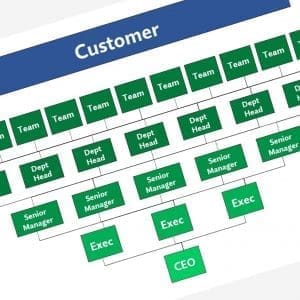Many enterprises find it difficult to sustain active collaboration environments that match the fervor of their internet-based inspirations. In this article, we look at three root cause challenges, and how the right Leadership moves can deal with the challenges and realize the benefits.
Center-Led Collaboration is an Oxymoron
Think about it … the successful collaboration environment is made up of connections between a large set of end points. The spirit of a true community looks to the value that is freely and naturally shared by the individuals, real people, at these end points. When you work in a collaborative way, sharing becomes part of the culture, a way of working that defines the group.
But if this form of communication is being driven by the person in charge, and made to be a requirement of the job, it may not feel 100% natural. Inevitably, the community will fall apart – especially when the person at the center changes. This is not a shared vision of connection, and it cannot last.
Then again …
Truth be told, center- led (or better, center-facilitated) collaboration is required for success in most organizations. Yes, you read that correctly – the community-of-practice model has a very difficult time taking hold in the organization. The difference maker is a strong central person or team that can lead by example, actively participating and learning what works and what does not with the team as whole.
Am I contradicting myself? Here’s the trick – in any organization, a strong central team that regularly leads by example should be in place before introducing this new way to work. Their efforts will generate winning stories and valuable examples, so the broader team can see the real benefits. For many teams, active collaboration with team members who are spread across the building (or around the globe) is something very new. It is easy and natural to connect when you can just walk down the hall and have a chat, but amazingly difficult when there is space and time gaps to overcome. Out of sight, out of mind is a challenge!
Center-Supported Collaboration is Required for Success
Let’s change the headline, and change the focus of our central leadership team, to drive success. It may be a subtle difference, but the central team that wants to deliver success through collaboration has to think through the challenges – and find solutions that work.
- Too Many Tools: Every year brings another tool for the harried knowledge worker, another method for capturing knowledge and monitoring the flow. Every new platform solves a separate challenge, and none can do everything; some want a user interface that mimics the news feed of Facebook, while others want a universal search as simple as Google.
What can the center-supporting team do? Define and encourage (not enforce) the standard. Listen to the input and adapt / branch out where necessary, but guide to a reasonably small set of tools/platforms.
- Not Enough Authors: Most of the complaints and concerns come from the knowledge consumer, and not the knowledge creator. In fact, that is typically the problem with corporate collaboration spaces – everyone wants to find the information, but no one is effectively capturing that knowledge in the first place. Everyone wants to read, no one want to write.
What can the center-supporting team do? Make content creation part of the daily job of your team. Require a certain number of documented tickets, white papers, process maps, etc. – and help people develop their written communication skills. And make it part of the teams’ annual review and objectives – if this new behavior is part of their compensation plan, you will get their attention.
- No Time for the Work: In some Lean / Six Sigma organizations, collaboration is challenging because sharing knowledge may been seen as muda, or waste. Opportunistic collaboration is by definition a lossy process – establishing an environment of possibilities means that lots of time will be spent on work that doesn’t generate an outcome. It only takes a few sparks of innovation to justify the investment in time, so getting things off the ground can be tricky (until that first connection comes to life).
What can the center-supporting team do? Prime the pump, by encouraging volumes of traffic (readers and creators). We can’t make these connections happen until the raw material is out there. While that is going on, invest the time in reviewing the inputs and actively looking for opportunities. And always be listening for those first small successes; get the stories out there, so others can be motivated to participate.
Collaboration is tough to scale inside a (relatively) small, closed community. Leaders must actively work to understand with the methods tools, promote – unless you really understand the methods (NOT the tools!!)
24 January, 2020






Comments (0)